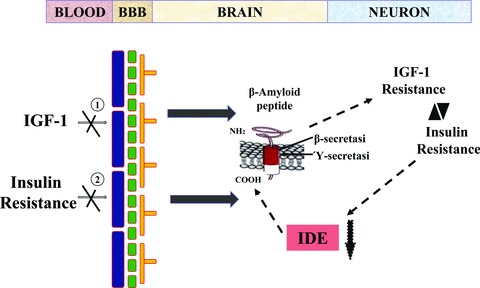Fig 3.

Reduced levels of (1) IGF-1 and peripheral (2) insulin resistance (IR) induced decrease uptake of IGF-1 and insulin into the brain, resulting in β amyloid accumulation. Increased levels of β amyloid antagonize insulin and IGF-1 binding to their corresponding receptors, worsening insulin/IGF-1 resistance in neurons. Neuronal IR contributes to accumulation of β amyloid by competing for insulin-degrading enzyme (IDE), a protease that degrades both insulin and β amyloid. Aβ accumulation can be linked to cellular metabolic conflict caused by τ hyperphosphorylation. Aβ accumulation can inhibit insulin actions and binding, and can also be neurotoxic.
